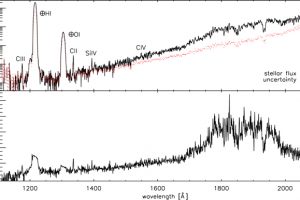Stellar activity suppressed by close-in exoplanets. The study “Suppressed Far-UV Stellar Activity and Low Planetary Mass Loss in the WASP-18 System” of L. Fossati (Space Research Institute – Austria) published by AJ

All the magnetic phenomena occurring in stars, such as flares and spots, are called “stellar activity”. Astronomers study stellar activity using different diagnostics such as X-ray emission from the coronae and spectroscopic indices like the R’HK measuring the chromospheric activity. This is an important research field in stellar astronomy, given that stellar activity is connected to the intensity and morphology of the magnetic field and the stellar internal structure and rotation, which is known to evolve with the age (stellar activity typically declines with stellar age).
In some of the stars with close-in Jupiter-like exoplanets (closer than a fraction of astronomical unit) it has been observed that the magnetic activity is affected by the presence of the planet. It has been shown that some of these stars are brighter in X-rays than expected (link), suggesting that close planets causes phenomena of magnetic reconnection between star and planet, inducing the creation of magnetic active regions on the surface of the star. Similar phenomena have been observed in the Solar System between Jupiter and its major moons (mainly Io). A different result has been obtained in the 2014 by Ignazio Pillitteri, astronomer of the Astronomical Observatory of Palermo (link), who discovered, using the NASA satellite Chandra, that the star WASP-18, hosting a close giant exoplanet, has a lower X-ray activity than stars with similar age and mass. This finding supports the hypothesis that close-in giant planets affect the mechanism responsible for the production of the magnetic field in host stars (i.e. the stellar dynamo), suppressing their magnetic activity.
This is the subject of the study “Suppressed Far-UV Stellar Activity and Low Planetary Mass Loss in the WASP-18 System” of L. Fossati (Space Research Institute, Austrian Academy of Sciences), which has been recently published by AJ with the collaboration of the astronomer Ignazio Pillitteri. In this paper, are analyzed UV spectra of the star WASP-18, taken with the spectrograph Cosmic Origins Spectrograph (COS) on board of the Hubble Space Telescope (HST). WASP-18 hosts a Jupiter-like planet of about 10 Jupiter masses orbiting at 0.02 AU from the star. Despite its young age (about 1 Gyr), WASP-18 has a very low activity level, comparable with that of stars with similar mass but more than 5 Gyrs old. From the analysis of carbon and silicon lines in the UV spectra of WASP-18, the authors of the paper have discarded the hypothesis that the observed low stellar activity may not be intrinsic but due to absorption by interstellar material or gas evaporated from the exoplanet. This is in agreement with the hypothesis that the close-in planet suppresses the magnetic activity in WASP-18, as suggested by the low X-ray emission found in the study published in 2014 by Ignazio Pillitteri (link).
The figure (link) shows the COS spectrum of WASP-18 with its signal-to-noise ratio.
